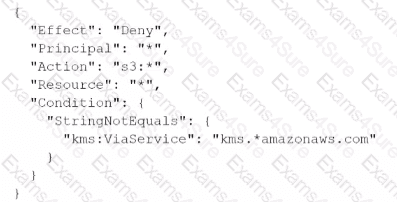AWS Certified Security - Specialty
Last Update 2 days ago
Total Questions : 467
AWS Certified Specialty is stable now with all latest exam questions are added 2 days ago. Incorporating SCS-C02 practice exam questions into your study plan is more than just a preparation strategy.
SCS-C02 exam questions often include scenarios and problem-solving exercises that mirror real-world challenges. Working through SCS-C02 dumps allows you to practice pacing yourself, ensuring that you can complete all AWS Certified Specialty practice test within the allotted time frame.
A company uses AWS Organizations and has production workloads across multiple AWS accounts. A security engineer needs to design a solution that will proactively monitor for suspicious behavior across all the accounts that contain production workloads.
The solution must automate remediation of incidents across the production accounts. The solution also must publish a notification to an Amazon Simple Notification Service (Amazon SNS) topic when a critical security finding is detected. In addition, the solution must send all security incident logs to a dedicated account.
Which solution will meet these requirements?
A security engineer is working with a company to design an ecommerce application. The application will run on Amazon EC2 instances that run in an Auto Scaling group behind an Application Load Balancer (ALB). The application will use an Amazon RDS DB instance for its database.
The only required connectivity from the internet is for HTTP and HTTPS traffic to the application. The application must communicate with an external payment provider that allows traffic only from a preconfigured allow list of IP addresses. The company must ensure that communications with the external payment provider are not interrupted as the environment scales.
Which combination of actions should the security engineer recommend to meet these requirements? (Select THRE
E.
)A company is undergoing a layer 3 and layer 4 DDoS attack on its web servers running on IAM.
Which combination of IAM services and features will provide protection in this scenario? (Select THREE).
An IAM user receives an Access Denied message when the user attempts to access objects in an Amazon S3 bucket. The user and the S3 bucket are in the same AWS account. The S3 bucket is configured to use server-side encryption with AWS KMS keys (SSE-KMS) to encrypt all of its objects at rest by using a customer managed key from the same AWS account. The S3 bucket has no bucket policy defined. The IAM user has been granted permissions through an IAM policy that allows the kms:Decrypt permission to the customer managed key. The IAM policy also allows the s3:List* and s3:Get* permissions for the S3 bucket and its objects.
Which of the following is a possible reason that the IAM user cannot access the objects in the S3 bucket?
A company is storing data in Amazon S3 Glacier. A security engineer implemented a new vault lock policy for 10 TB of data and called the initiate-vault-lock operation 12hours ago. The audit team identified a typo in the policy that is allowing unintended access to the vault.
What is the MOST cost-effective way to correct this error?
A company has deployed Amazon GuardDuty and now wants to implement automation for potential threats. The company has decided to start with RDP brute force attacks that come from Amazon EC2 instances in the company’s AWS environment. A security engineer needs to implement a solution that blocks the detected communication from a suspicious instance until investigation and potential remediation can occur.
Which solution will meet these requirements?
A company stores sensitive documents in Amazon S3 by using server-side encryption with an IAM Key Management Service (IAM KMS) CMK. A new requirement mandates that the CMK that is used for these documents can be used only for S3 actions.
Which statement should the company add to the key policy to meet this requirement?
A)

B)

A developer is building a serverless application hosted on AWS that uses Amazon Redshift as a data store The application has separate modules for readwrite and read-only functionality The modules need their own database users for compliance reasons
Which combination of steps should a security engineer implement to grant appropriate access? (Select TWO.)
A security engineer is configuring AWS. Config for an AWS account that uses a new 1AM entity When the security engineer tries to configure AWS. Config rules and automatic remediation options, errors occur in the AWS CloudTrail logs the security engineer sees the following error message "Insufficient delivery policy to s3 bucket DOC-EXAMPLE-BUCKET, unable to write to bucket provided s3 key prefix is 'null'."
Which combination of steps should the security engineer take to remediate this issue? (Select TWO.)
A company is running an application on Amazon EC2 instances in an Auto Scaling group. The application stores logs locally. A security engineer noticed that logs were lost after a scale-in event. The security engineer needs to recommend a solution to ensure the durability and availability of log data All logs must be kept for a minimum of 1 year for auditing purposes. What should the security engineer recommend?


TESTED 16 Nov 2025
Hi this is Romona Kearns from Holland and I would like to tell you that I passed my exam with the use of exams4sure dumps. I got same questions in my exam that I prepared from your test engine software. I will recommend your site to all my friends for sure.
Our all material is important and it will be handy for you. If you have short time for exam so, we are sure with the use of it you will pass it easily with good marks. If you will not pass so, you could feel free to claim your refund. We will give 100% money back guarantee if our customers will not satisfy with our products.